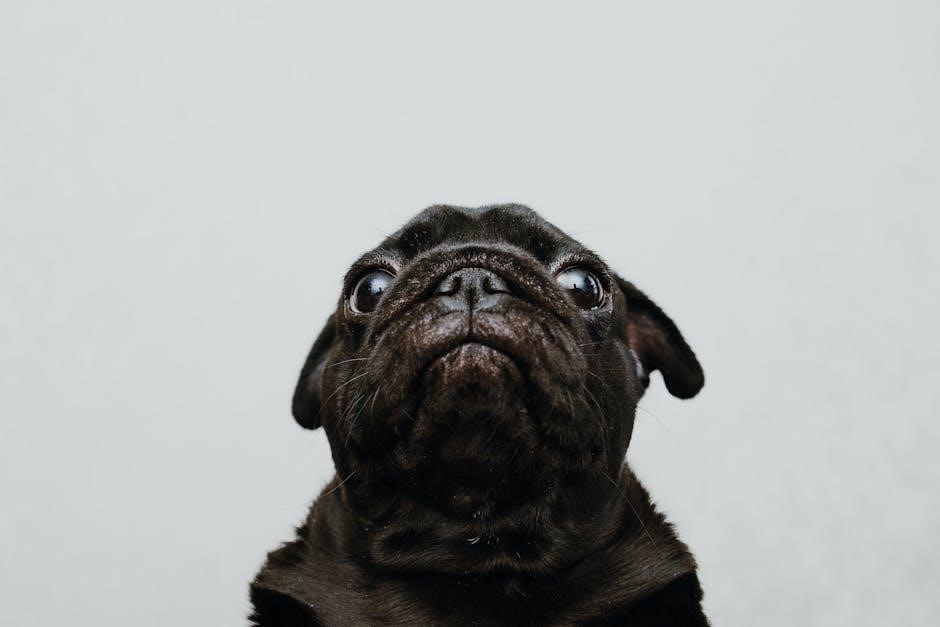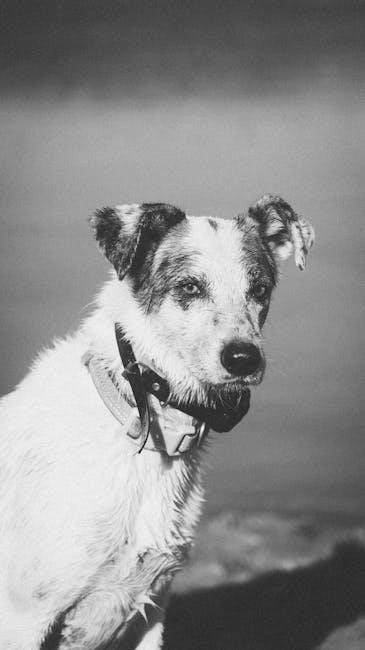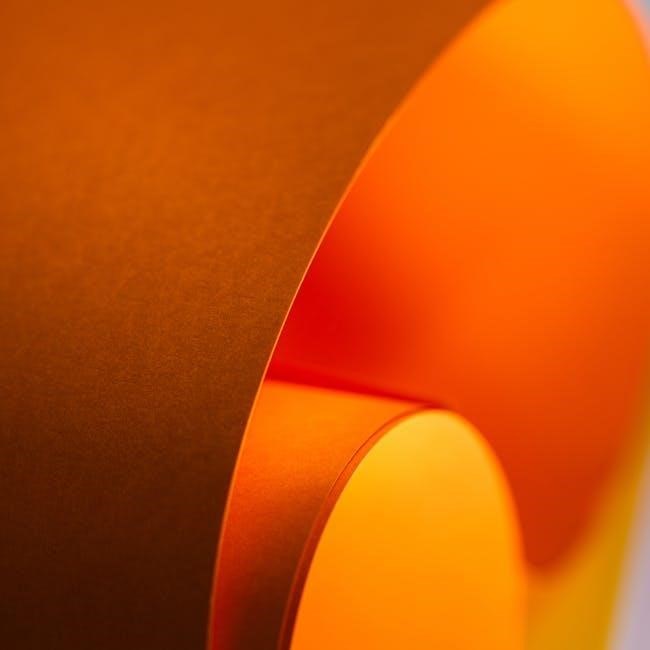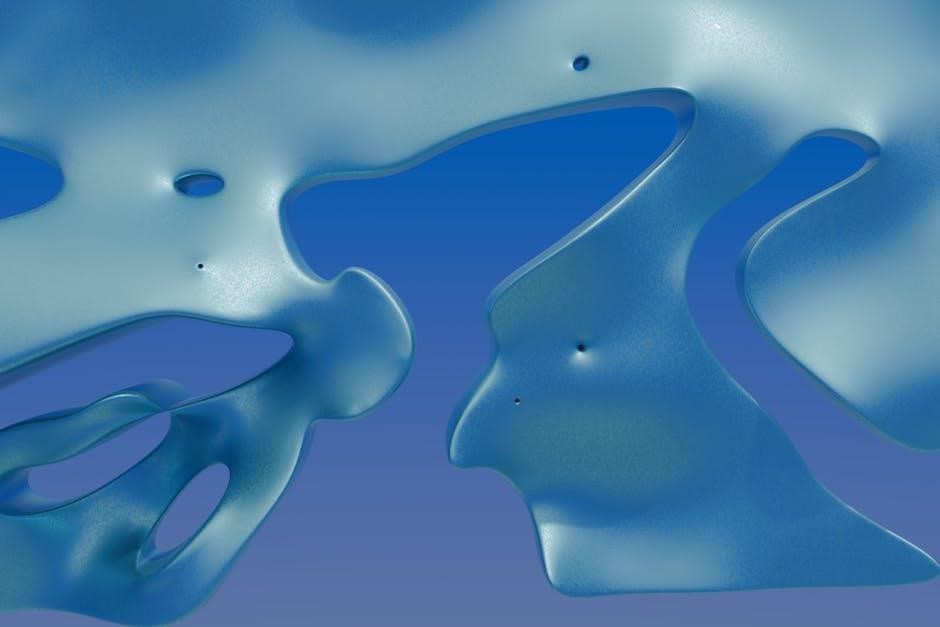baskerville dog muzzle size guide
The Baskerville Ultra Muzzle is a popular choice for dog owners, offering a humane design that allows dogs to pant and drink comfortably. Its heat-shapeable and adjustable features ensure a custom fit, making it ideal for daily walks and training sessions while prioritizing comfort and safety.
Why Proper Size Matters for Dog Muzzles
Proper sizing is crucial for your dog’s comfort and safety. A muzzle that’s too tight can restrict breathing and cause discomfort, while one that’s too loose may not provide adequate control. The Baskerville Ultra Muzzle is designed to allow panting and drinking, ensuring your dog stays comfortable during walks or training. Measuring your dog’s snout length and circumference accurately ensures a secure yet humane fit. A well-fitted muzzle prevents irritation and ensures your dog can behave naturally. Always refer to the Baskerville size chart to avoid sizing errors and guarantee a safe, stress-free experience for your dog.
Overview of Baskerville Muzzle Design
The Baskerville muzzle is renowned for its innovative design, combining durability with flexibility. Made from a tough yet pliable rubber compound, it provides structural integrity while allowing natural jaw movement. Its heat-shapeable feature ensures a custom fit for your dog’s unique snout shape. The muzzle’s open design enables panting and drinking, promoting comfort during use. It also features a secure loop attachment system to prevent slipping. Lightweight and ergonomic, the Baskerville muzzle minimizes discomfort while maintaining control. Its thoughtful design balances safety, comfort, and effectiveness, making it a popular choice for training and everyday walks. This design ensures your dog remains calm and stress-free in various situations.
Understanding Baskerville Muzzle Features
Baskerville muzzles are designed for comfort and control, featuring durable rubber, adjustable straps, and a heat-shapeable fit. They allow panting and drinking while ensuring safety and ease of use.
Key Features of Baskerville Ultra Muzzles
The Baskerville Ultra Muzzle is renowned for its heat-shapeable design, allowing a custom fit for your dog’s snout. It features adjustable straps for secure fastening and a durable rubber construction that ensures both comfort and strength. The muzzle is designed to permit panting and drinking, making it practical for extended use. Its open basket-style design provides excellent ventilation while maintaining control. The Ultra Muzzle is also easy to clean and comes in various sizes to suit different breeds. These features make it a popular choice for training, walking, and managing dogs in public settings.
Benefits of Adjustable and Heat-Shaped Muzzles
Adjustable and heat-shaped muzzles offer unparalleled comfort and security for dogs. The heat-shaping feature allows the muzzle to conform to your dog’s unique snout shape, ensuring a perfect fit and preventing chafing. Adjustable straps provide a secure fastening system, reducing the risk of the muzzle slipping during use. These muzzles also promote stress-free training and social interactions by allowing your dog to pant and drink naturally. Their durable construction ensures long-term reliability, while the customizable fit enhances comfort for extended wear. These features make adjustable and heat-shaped muzzles ideal for dogs requiring a balance of control and comfort in various situations.
How to Measure Your Dog for a Baskerville Muzzle
Accurate measurements ensure the best fit. Measure your dog’s snout length, circumference, and open mouth using a soft tape measure. Ensure your dog remains calm during the process for precise results.

Step-by-Step Measuring Guide for Snout Length
Measure your dog’s snout length by gently placing a soft tape measure or string from the tip of the nose to the base, just below the eyes. Ensure the tape is level and not twisted. Repeat the process to confirm accuracy. For consistency, take multiple measurements and average them. This ensures the muzzle fits comfortably without restricting breathing or movement. Avoid pulling the tape too tight or leaving it too loose, as this can lead to an ill-fitting muzzle. Proper snout length measurement is critical for selecting the right size from the Baskerville muzzle size chart.
How to Measure Snout Circumference Accurately
To measure your dog’s snout circumference accurately, wrap a soft tape measure or string around the widest part of their snout, typically just below the eyes and level with the nose. Ensure the tape is not too tight or too loose, maintaining a natural fit. Take note of the measurement where the tape overlaps. For consistency, repeat the process a few times and average the results. This measurement is crucial for determining the correct muzzle size, as it ensures the muzzle will fit comfortably without causing discomfort or restriction. Accurate snout circumference is essential for proper fit and functionality of the Baskerville muzzle.

Measuring Your Dog’s Open Mouth
Measuring your dog’s open mouth is essential for ensuring the muzzle allows proper panting and drinking. To do this, gently encourage your dog to open its mouth by offering a treat or toy. Use a ruler to measure the length from the tip of the nose to the back of the mouth. Also, measure the width across the jaw. Record these measurements carefully. This step ensures the muzzle is not too tight or restrictive, allowing your dog to breathe and function comfortably. Accurate open mouth measurements are vital for selecting the right size of Baskerville muzzle, ensuring both comfort and effectiveness.

Baskerville Muzzle Size Chart
The Baskerville Muzzle Size Chart provides detailed measurements for sizes 1-6, ensuring a proper fit. It includes snout length, circumference, and weight guidelines, with a link to the official chart for accurate sizing.
Size 1-6: Detailed Measurements and Corresponding Sizes
The Baskerville Muzzle Size Chart categorizes sizes from 1 to 6, each tailored to specific snout lengths and circumferences. Size 1 suits small breeds with a snout length of 2-3 inches, while Size 6 accommodates larger breeds with a snout length of 14-15 inches. Each size corresponds to precise measurements, ensuring a comfortable and secure fit. For example, Size 3 is ideal for medium breeds like French Bulldogs, with a snout length of 8-9 inches and a circumference of 10-11 inches. Refer to the official chart for exact dimensions to match your dog’s measurements accurately. Proper sizing ensures comfort and functionality.

How to Match Your Dog’s Measurements to the Size Chart
To ensure the best fit, align your dog’s snout length and circumference with the Baskerville Muzzle Size Chart. Measure accurately, then compare the results to the chart’s size range. For example, if your dog’s snout length is 10 inches and circumference is 12 inches, refer to the chart to find the corresponding size. Double-check that the measurements fall within the provided range for the recommended size. If your dog’s measurements are between sizes, consider their comfort and ability to pant. Adjustments may be needed for breeds with unique snout shapes. Always prioritize a snug yet comfortable fit for optimal performance and your dog’s well-being.

Choosing the Right Muzzle Size for Your Dog
Selecting the correct muzzle size ensures comfort and functionality. Consider your dog’s breed, weight, and snout shape. Consider the Baskerville size chart for accurate fitting. Proper fit ensures your dog can pant and drink comfortably, while preventing unwanted behavior. Measure carefully and choose a size that aligns with your dog’s unique dimensions. A well-fitting muzzle promotes safety and satisfaction for both you and your dog.
Weight and Breed Guidelines for Muzzle Sizing
When selecting a muzzle size, consider your dog’s weight and breed. Smaller breeds (under 20 lbs) typically fit sizes 1-2, while larger breeds (50+ lbs) may require sizes 4-6. Use the Baskerville size chart as a guide, but remember that individual variations exist. For example, a muscular dog may need a larger size than its weight suggests. Always prioritize proper fit to ensure comfort and safety.
Breed-specific traits, like brachycephalic snouts or elongated muzzles, also influence sizing. Consult the chart and consider your dog’s unique features. If unsure, contact customer support for personalized recommendations to ensure the best fit for your dog.
Ensuring Your Dog Can Pant and Drink Comfortably
A well-fitted Baskerville muzzle allows your dog to pant and drink freely, essential for comfort and health. The muzzle’s design ensures ample space around the snout, preventing restriction of airflow. Proper sizing is crucial to avoid obstruction of the mouth. Choose a muzzle that permits your dog to open its mouth slightly, enabling panting for temperature regulation. Test the fit by offering water to ensure your dog can drink without difficulty. A comfortable muzzle balances safety with your dog’s basic needs, making it suitable for extended wear during walks or training sessions.
How to Select the Best Size for Daily Walks and Training
Selecting the right Baskerville muzzle size for daily walks and training ensures your dog’s comfort and safety. A muzzle that is too tight can restrict movement and breathing, while one that is too loose may not provide adequate control. Start by referring to the size chart and your dog’s measurements. Consider your dog’s activity level and the duration of walks or training sessions. A snug, secure fit allows for clear panting and drinking, while preventing unwanted behaviors. Test the muzzle during short sessions and adjust as needed to ensure comfort and functionality. Proper sizing ensures your dog remains calm and cooperative during outings.

Common Mistakes When Selecting a Muzzle Size
Common mistakes include guessing size without measuring, ignoring breed-specific needs, and not accounting for the dog’s growth or seasonal changes in weight and snout shape.
The Risks of Choosing a Muzzle That’s Too Tight
Choosing a muzzle that’s too tight can lead to significant discomfort for your dog. It may restrict breathing and panting, essential for cooling down. A tight muzzle can also cause skin irritation or even infections due to excessive rubbing. Additionally, it may limit your dog’s ability to drink water or eat treats, leading to frustration. Prolonged use of an overly tight muzzle can result in anxiety or aggression, as your dog may associate the discomfort with the muzzle itself. Always ensure a snug but comfortable fit to prevent these issues and promote a positive experience for your dog.
The Dangers of a Muzzle That’s Too Loose
A muzzle that’s too loose can pose significant risks, as it may slip off during critical moments, such as training or social interactions. This could lead to unintended biting or aggression, especially in situations where the muzzle was intended to prevent such behavior. A loose muzzle also fails to provide consistent control, making it unreliable for its intended purpose. Additionally, the dog may find it easier to remove the muzzle entirely, rendering it ineffective. A properly fitted muzzle is essential to ensure safety, comfort, and reliability. Always prioritize a secure fit to avoid potential accidents and maintain trust in the muzzle’s performance during daily use.

Fitting and Adjusting the Baskerville Muzzle
Fitting and adjusting the Baskerville muzzle ensures a secure, comfortable fit. Heat-shaping and strap adjustments allow customization for your dog’s unique features and needs.
How to Heat-Shape the Muzzle for a Custom Fit

To heat-shape the Baskerville muzzle for a custom fit, start by warming the plastic using a hairdryer or hot water until it becomes pliable. Once softened, gently mold the muzzle to match your dog’s snout shape. Ensure even heating to avoid uneven softening. After shaping, allow the muzzle to cool completely to set the new form. This process ensures a tailored fit, enhancing comfort and functionality for your dog.
Adjusting the Straps for Maximum Comfort and Security
Adjusting the straps of a Baskerville muzzle is crucial for ensuring both comfort and security. Start by placing the muzzle on your dog and gently tightening the straps until it fits snugly. Ensure the muzzle isn’t too tight, as this can cause discomfort, but also avoid leaving it too loose, which may compromise safety. Use the adjustable buckles to customize the fit, making sure your dog can pant and drink easily. Regularly check the straps to maintain the proper fit, especially as your dog becomes accustomed to wearing the muzzle. Properly adjusted straps ensure a secure, comfortable, and safe experience for your dog.
The Baskerville muzzle is a durable, comfortable, and adjustable solution for dogs, designed to promote safety while allowing natural panting and drinking. Perfect for various breeds and situations.
How to Introduce Your Dog to the Muzzle
Introducing your dog to the Baskerville muzzle requires patience and positivity. Start by letting your dog see and sniff the muzzle while offering treats to create a positive association. Gradually place the muzzle on their snout for short periods, rewarding calm behavior. Avoid forcing it on, as this can cause anxiety. Begin with short sessions, such as during meals or walks, and slowly increase the duration. Ensure your dog can pant, drink, and move comfortably. If your dog shows signs of discomfort, remove the muzzle and try again later. Consistency and positive reinforcement are key to a smooth transition.
Training Tips for a Smooth Transition
Training your dog to accept the Baskerville muzzle starts with positive reinforcement. Begin by letting your dog explore the muzzle at their own pace, offering treats to build trust. Gradually introduce wearing it during calm activities, like eating or short walks, to normalize the experience. Use clear, consistent commands to help your dog associate the muzzle with positive outcomes. Avoid rushing the process, as this can create resistance. Reward your dog for remaining calm and composed. Over time, your dog will learn to accept the muzzle as a routine part of their behavior management, ensuring a stress-free experience for both you and your pet.

Baskerville Muzzle User Reviews and Testimonials
Users praise Baskerville muzzles for their durability and comfort, with many noting improved walking experiences. Owners highlight how the adjustable design ensures a secure fit. Some mention it helps with aggression issues, while others appreciate the ease of cleaning. A few users found sizing challenging, but overall, the muzzle is well-regarded for its effectiveness in training and behavior management.
Real-Life Experiences with Baskerville Muzzles
Dog owners share diverse experiences with Baskerville muzzles, emphasizing their effectiveness in addressing aggression, anxiety, and training challenges. Many report successful use during walks, vet visits, and social interactions. Owners of breeds like Labradors and German Shepherds praise the muzzle’s durability and comfort, while smaller breed owners appreciate its lightweight design. Some users highlight how the adjustable straps and heat-shaped fit ensure their dogs can pant and drink freely. A few note that consistent training and gradual introduction are key to their dogs’ acceptance. Overall, real-life stories showcase the muzzle’s versatility and its positive impact on dog behavior and owner confidence.
Common Praise and Criticisms from Dog Owners
Dog owners frequently praise Baskerville muzzles for their durability, comfort, and adjustable design, which allows for a secure yet non-restrictive fit. Many appreciate how the muzzles prevent biting while still enabling panting and drinking. The heat-shaping feature is a standout, providing a customized fit for various snout shapes. However, some owners note that sizing can be tricky, and the muzzles may not suit dogs with very short or flat faces. A few users mention that the straps can sometimes rub uncomfortably if not adjusted properly. Overall, the Baskerville muzzle is well-regarded for its practicality and effectiveness, though proper fitting is essential for optimal comfort and performance;
Troubleshooting Common Fitting Issues
Troubleshooting common fitting issues involves adjusting straps, ensuring proper sizing, and addressing discomfort. Resizing or re-shaping the muzzle may be necessary for optimal comfort and functionality.
What to Do If the Muzzle Doesn’t Fit Properly
If the muzzle doesn’t fit properly, start by rechecking your dog’s measurements against the size chart. Ensure accurate snout length and circumference. Adjust the straps for a secure yet comfortable fit. If the muzzle feels too tight or restrictive, consider going up a size. For a loose fit, tighten the straps or opt for a smaller size. The Baskerville muzzle can be heat-shaped for a custom fit; use a hairdryer on low heat to mold it to your dog’s snout. Allow it to cool before reapplying. If discomfort persists, consult the manufacturer or a professional for guidance. Proper fit is crucial for your dog’s comfort and safety.
How to Address Discomfort or Restriction
If your dog shows signs of discomfort or restriction, such as excessive pawing or labored breathing, inspect the muzzle fit. Ensure the muzzle allows proper panting and drinking. If the straps are too tight, loosen them slightly while maintaining security. The Baskerville muzzle’s adjustable straps can be fine-tuned for comfort. If heat-shaping was done, check that the mold isn’t pressing too firmly on sensitive areas. Reheat and reshape if necessary. If discomfort persists, consider consulting a professional groomer or trainer for assistance. Prioritize your dog’s comfort to prevent stress and ensure a positive experience with the muzzle.
Ensuring a proper fit is key to your dog’s comfort and safety. By following the guide, you can select the right Baskerville muzzle size for a secure fit.
Final Tips for Ensuring the Best Fit
Regularly check the fit of your Baskerville muzzle, especially as your dog grows or gains/loses weight. Ensure your dog can pant, drink, and move comfortably. Gradually introduce the muzzle during training sessions to build trust. Monitor for signs of discomfort or restriction, such as difficulty breathing or skin irritation. If issues arise, adjust the straps or consult a professional. Proper fit ensures safety, comfort, and effective use of the muzzle during walks or training. Always prioritize your dog’s well-being by maintaining a secure yet non-restrictive fit. This approach guarantees a positive experience for both you and your pet.
Where to Find Additional Resources and Support
For further guidance on Baskerville muzzle sizing, visit the official manufacturer website or consult their customer support team. Pet forums, dog training communities, and veterinary clinics often provide valuable insights and personalized advice. YouTube tutorials and instructional videos can also offer visual guidance for proper fitting. Additionally, local pet supply stores may host workshops or one-on-one consultations to ensure the best fit for your dog. Reaching out to experienced dog owners or trainers can provide real-world tips and reassurance. These resources will help you make informed decisions and ensure your dog’s comfort and safety with their Baskerville muzzle.




















